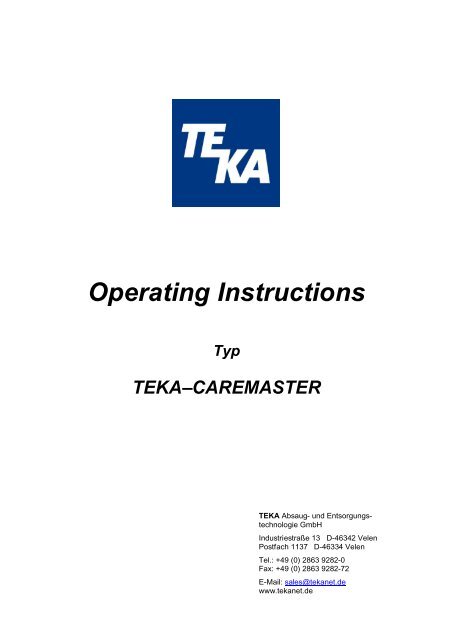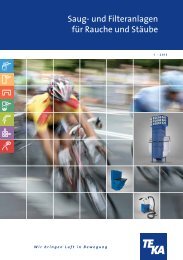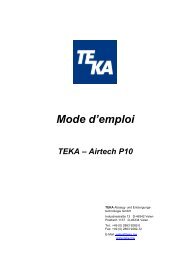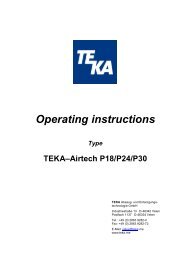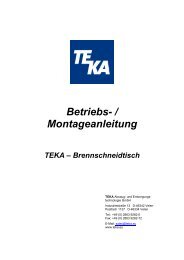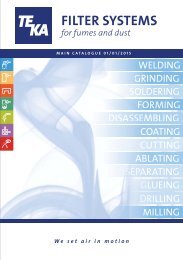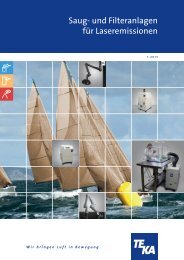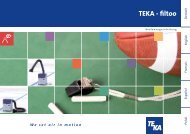You also want an ePaper? Increase the reach of your titles
YUMPU automatically turns print PDFs into web optimized ePapers that Google loves.
<strong>Operating</strong> <strong>Instructions</strong><br />
Typ<br />
<strong>TEKA</strong>–CAREMASTER<br />
<strong>TEKA</strong> Absaug- und Entsorgungstechnologie<br />
<strong>GmbH</strong><br />
Industriestraße 13 D-46342 Velen<br />
Postfach 1137 D-46334 Velen<br />
Tel.: +49 (0) 2863 9282-0<br />
Fax: +49 (0) 2863 9282-72<br />
E-Mail: sales@tekanet.de<br />
www.tekanet.de
Contents<br />
1 . Diagram/description of the components................................................................................................... 3<br />
2 . Preface ................................................................................................................................................... 5<br />
3 . Function of the <strong>TEKA</strong> - CAREMASTER ................................................................................................... 6<br />
4 . Safety instructions................................................................................................................................... 6<br />
5 . Commissioning ....................................................................................................................................... 8<br />
5.1 .. Attaching the extractor fittings.......................................................................................................... 8<br />
5.2 .. Electrical connection of the unit........................................................................................................ 9<br />
6 . Explanation of the controls ...................................................................................................................... 9<br />
7 . Maintenance ........................................................................................................................................... 9<br />
7.1 .. Changing of pre-filter ..................................................................................................................... 10<br />
7.2 .. Changing of particle filter ............................................................................................................... 11<br />
8 . Disposal................................................................................................................................................ 11<br />
9 ..Technical data....................................................................................................................................... 12<br />
10 Parts list................................................................................................................................................ 13<br />
11 Declaration of conformity <strong>TEKA</strong>-CAREMASTER................................................................................... 14<br />
BA_Caremaster_091216_GB.doc - 2 - 2009-12-16
1 Diagram/description of the components<br />
Caremaster with 1 suction elements<br />
Pos.1<br />
Pos.2<br />
Pos.3<br />
Pos.4<br />
Pos.6<br />
Pos.7<br />
Pos.8<br />
Pos.9<br />
Pos.10<br />
Pos.11<br />
Pos.12<br />
Power switch<br />
<strong>Operating</strong> hour counter<br />
<strong>Operating</strong> status lamp: green<br />
Volume flow control lamp : red<br />
Suction arm with suction hood or<br />
connecting piece<br />
Lid<br />
Hand grip<br />
Filter housing<br />
Filter door<br />
Ventilator housing<br />
Ventilator door<br />
Pos.13<br />
Pos.14<br />
Pos.15<br />
Pos.16<br />
Pos.17<br />
Pos.18<br />
Pos.19<br />
Pos.20<br />
Pos.21<br />
Pos.22<br />
Pos.23<br />
Pre-filter tray<br />
Pre-filter element<br />
Particle filter<br />
Lifting device<br />
Lock for lifting device<br />
Castor with brake<br />
Castor<br />
Bolt for attaching arm<br />
Washer for attaching arm<br />
Rotary flange<br />
Mains supply cable with mains connector<br />
BA_Caremaster_091216_GB.doc - 3 - 2009-12-16
Caremaster with 2 suction elements<br />
Pos.1<br />
Pos.2<br />
Pos.3<br />
Pos.4<br />
Pos.6<br />
Pos.7<br />
Pos.8<br />
Pos.9<br />
Pos.10<br />
Pos.11<br />
Pos.12<br />
Power switch<br />
<strong>Operating</strong> hour counter<br />
<strong>Operating</strong> status lamp: green<br />
Volume flow control lamp : red<br />
Suction arm with suction hood or<br />
connecting piece<br />
Lid<br />
Hand grip<br />
Filter housing<br />
Filter door<br />
Ventilator housing<br />
Ventilator door<br />
Pos.13<br />
Pos.14<br />
Pos.15<br />
Pos.16<br />
Pos.17<br />
Pos.18<br />
Pos.19<br />
Pos.20<br />
Pos.21<br />
Pos.22<br />
Pos.23<br />
Pre-filter tray<br />
Pre-filter element<br />
Particle filter<br />
Lifting device<br />
Lock for lifting device<br />
Castor with brake<br />
Castor<br />
Bolt for attaching arm<br />
Washer for attaching arm<br />
Rotary flange<br />
Mains supply cable with mains connector<br />
BA_Caremaster_091216_GB.doc - 4 - 2009-12-16
2 Preface<br />
One sector of extraction equipment has become very significant in recent years. The filtering of<br />
extracted pollutants and the recycling of filtered air to the working area.<br />
This is a surely a sign that the environmental consciousness of every one of us has altered very strongly<br />
in favour of our environment. For a long time now, no one has denied that pollution occurs during<br />
production. However, the pollutants depend on the process that is used. One can basically distinguish<br />
between gases and fumes (smoke). Fumes could also really be described as dust. If you examine this<br />
dust under a microscope, you will find that they consist of very fine particles, often with a size of 1 µm or<br />
smaller, that can enter the lungs.<br />
The classical method of trying to improve the working conditions of polluted workplaces is general<br />
ventilation. In this case, the general rule is a multiple change of air in the workshop, i.e. the complete<br />
volume of air in the workshop is replaced. However, this method only achieves a small reduction in the<br />
level of pollution within the breathing space of the user.<br />
The same applies to “overhead”extraction, i.e. the installation of large extractor hoods above the<br />
workplaces. This is the worst airflow imaginable, since the pollutants first pass through the breathing<br />
space of the user, and only afterwards are they contained and extracted. This is surely not the point of<br />
the exercise. A much more effective method than overhead/wide-area extraction is the removal of<br />
pollutants directly at their source, with localised extraction. Both the investment and the operating costs<br />
are much, much lower if localised extraction is used.<br />
The environmental and workplace-safety measures are especially important requirements for successful<br />
application of a technology, in addition to the technological optimisation of the processing method. In a<br />
time of increasing sensitivity and tougher legislation, the task therefore lies in making an early<br />
assessment of the potential hazards for the workplace and the environment, and reducing them as<br />
appropriate.<br />
BA_Caremaster_091216_GB.doc - 5 - 2009-12-16
3 Function of the <strong>TEKA</strong>-CAREMASTER<br />
The <strong>TEKA</strong>–SF filter unit is primarily used for localised extraction of dust and smoke particles. For this<br />
purpose, the unit can be equipped with one arm.<br />
Limits of application:<br />
welding fumes with oil mist, aluminium dust, gases, water etc.<br />
(If you are uncertain, please contact the manufacturer!)<br />
The polluted air is sucked into the extractor hood (or application-specific fitting) and transported through<br />
the extractor arm (or extractor hose) to the filter unit. Here, the coarse dust particles are collected in the<br />
pre-filter mat (Pos.14). The subsequent particle filter (Pos.15) traps extremely fine dust particles with an<br />
efficiency of better than 99%. The clean air passes the fan and the noise attenuation module and<br />
returns upward into the room via the exhaust grid. The filtered air is then sucked in by the ventilator and<br />
recycled to the air in the workshop through the exhaust grille at the back of the unit.<br />
Caution:<br />
As soon as the resistance to the air flow from the accumulated dust particles on the filter cartridge<br />
markedly effects the suction performance, the filter elements shall be exchanged.<br />
(refer to chapter 7.1: “Changing of pre-filter mat“, chapter 7.2: “Change of particle filter“)<br />
4 Safety instructions<br />
When using electrical equipment, the following basic safety rules must be observed, for protection<br />
against electric shock, injury, or fire hazards.<br />
• Before using the equipment, read and observe these instructions!<br />
• Keep the operating and maintenance instructions in a safe place!<br />
• Never use the equipment to extract easily inflammable or explosive gases!<br />
• Never use the equipment for the extraction of corrosive substances!<br />
• Never use the equipment for the extraction of burning or glowing material!<br />
• Never use the equipment to suck up any kind of liquid!<br />
• Do not use the equipment for the extraction of organic substances without written approval from the<br />
manufacturer!<br />
• Protect the connectors from heat, moisture, oil, and sharp edges!<br />
• Keep to the permitted supply voltage! (Observe the data on the nameplate!)<br />
• Use only <strong>TEKA</strong> replacement parts!<br />
BA_Caremaster_091216_GB.doc - 6 - 2009-12-16
• Do not operate the equipment without a filter insert!<br />
• Disconnect the supply voltage before opening the filter unit!<br />
• The exhaust vent must not be covered up or blocked!<br />
Always take care that the unit is standing in a stable position, and that the brakes on the castors are<br />
on!<br />
• The filter unit must be disconnected from the mains supply voltage before cleaning or maintenance,<br />
replacing parts, or a functional conversion!<br />
• The filter inserts cannot be regenerated!<br />
• Dispose of the filter inserts in accordance with the regulations!<br />
• If an energy-saving automatic start/stop is being used, the earthing cable must be checked for<br />
possible damage before every welding session.<br />
• The unit must not be used if the earthing cable is not in perfect condition.<br />
• If external filter controls are used, the control cable must be checked for possible damage before<br />
every operating session.<br />
• The unit must not be used if the control cable is not in perfect condition!<br />
• The mains supply cable for the unit must be checked regularly for possible damage!<br />
• The unit must not be used if the mains supply cable is not in perfect condition!<br />
• Do not use the filter unit if one or more of its components are faulty, missing, or damaged. In any of<br />
these cases, please call the <strong>TEKA</strong> service department on ++49-(0) 151-2874775.<br />
• When extracting carcinogenic welding fumes as from the processing of nickel or chrome alloys, the<br />
requirements of the directives on clean air of the German TRGS 560 ‘Return of process air when<br />
working with carcinogenic media’must be observed. (And/or the equivalent national directives for the<br />
respective user.)<br />
Further information regarding the TRGS 560 can be obtained from the<br />
‘BIA - Berufsgenossenschaftliches Institut für Arbeitssicherheit’<br />
(Institute for work safety of the employers’liability insurance)<br />
D-53754 Sankt Augustin, Germany.<br />
BA_Caremaster_091216_GB.doc - 7 - 2009-12-16
5 Commissioning<br />
The filter unit is supplied with all connections.<br />
The extractor fittings and possibly other accessory equipment, must be installed or mounted on the unit<br />
before commissioning.<br />
5.1 Attaching the extractor fittings<br />
The extractor fitting (e.g. an extractor hose or an extractor arm) must be mounted on the extractor<br />
spouts or the housing cover.<br />
If an extractor arm is used, it is attached by using the flange ring (Pos.22), bolts (Pos.20) and washers<br />
(Pos.21) that are provided.<br />
Warning:<br />
Please take care that the spout is now able to rotate.<br />
BA_Caremaster_091216_GB.doc - 8 - 2009-12-16
5.2 Electrical connection of the unit<br />
• Connect the filter unit to the mains supply. (Observe the data on the nameplate!)<br />
Warning:<br />
Work on the electrical sections must only be carried out by qualified and authorized personnel.<br />
(Observe the data on the nameplate!)<br />
6 Explanation of the controls<br />
Pos.1<br />
The main switch switches the filter unit on or off.<br />
Pos.2<br />
Pos.3<br />
Pos.4<br />
The operating hour counter starts to count as soon as the filter unit will be switch on.<br />
The operating status lamp shows if the filter unit will be switch on.<br />
The indicator lamp for flow volume shows whether the suction power is adequate. If it lights<br />
up, the filter inserts must be replaced.<br />
7 Maintenance<br />
The accumulation of extracted particles on the filter cartridge will eventually lead to a reduction of the<br />
suction / extraction performance.<br />
The mechanical filter element ensures that more than 99% of the extracted pollutants are retained in the<br />
filter. This also applies to a partially or fully saturated filter. However, the extraction performance of the<br />
filter unit will decrease as the filter elements becomes saturated more and more.<br />
The pre-filter (Pos.14) must be changed at regular intervals. (Refer to chapter 6.1 ‘Changing of pre-filter<br />
element’)<br />
When the internal resistance of the filter element has increased due to the accumulation of the<br />
separated dust particles and the extraction performance of the filter unit decreases as a whole, the<br />
particle filter (Pos. 15) must be changed. (Refer to chapter 6.2 ‘Changing of particle filter element’)<br />
Caution :<br />
When changing the filter cartridge, the operation of the filter unit must be interrupted.<br />
Exchange of the filter cartridge and the disposal of the element may be executed only in amply<br />
ventilated environments and when using an appropriate protective respiratory mask.<br />
We recommend to use a respiratory mask to DIN EN 141/143 - Protection class P3.<br />
The job of changing the filter elements should be executed by trained personnel only. Filter disposal<br />
according to pertinent directives on special waste handling.<br />
Manually beating the filter element, washing or air jet blasting will destroy the filter media. As a result<br />
the pollutants will be blown into the room.<br />
BA_Caremaster_091216_GB.doc - 9 - 2009-12-16
7.1 Changing of pre-filter<br />
The pre-filter mat (Pos.14) must be changed after a certain number of operating hours. The time<br />
depends on the amount of accumulated dust. At the latest, the filter mat must be changed when<br />
changing the particle filter.<br />
The procedure is a follows:<br />
• Disconnect the filter unit from the mains power supply.<br />
• Open the air filter access door (Pos.10).<br />
• Lower the lifting mechanism (Pos.16) by turning the lock screw (Pos.17) downward..<br />
• Pull out the pre-filter tray (Pos.13).<br />
• Take out the pre-filter mat (Pos.14).<br />
• Install the new pre-filter mat.<br />
Caution :<br />
Only use original <strong>TEKA</strong> pre-filter elements.<br />
• Insert the pre-filter tray (Pos.13).<br />
• Raise the lifting mechanism (Pos.16) by turning the locking screw (Pos.17) until the pre-filter<br />
tray (Pos.13) sits tight. (At this time check the sealing gasket under the lid (Pos.7) for possible<br />
damage.<br />
• Close the filter access door (Pos.10).<br />
Connect the filter unit to the mains circuit. (Refer to the data on the type plate)<br />
BA_Caremaster_091216_GB.doc - 10 - 2009-12-16
7.2 Changing of particle filter<br />
When the extraction performance decreases, the particle filter must be changed according to the<br />
following procedure:<br />
• Disconnect the filter unit from the mains power supply..<br />
• Open the filter access door (Pos.10).<br />
• Lower the lifting mechanism (Pos.16) by turning the locking screw (Pos.17) downward..<br />
• Pull out the particle filter (Pos.15).<br />
• Install the new particle filter element<br />
Caution :<br />
Only use original <strong>TEKA</strong> particle filter elements.<br />
• Raise the lifting mechanism (Pos.16) by turning the locking screw (Pos.17) until the pre-filter<br />
tray (Pos.13) sits tight. (At this time check the sealing gasket under the lid (Pos.7) for possible<br />
damage.<br />
• Close the filter access door (Pos.10).<br />
Connect the filter unit to the mains circuit. (Refer to the data on the type plate)<br />
8 Disposal<br />
To ensure perfect operation of your <strong>TEKA</strong> - CAREMASTER extractor unit and proper disposal of the<br />
dust that has been extracted, we offer the following services:<br />
• Help with finding a waste disposal company in your vicinity.<br />
• On request, we can supply a list of all waste disposal companies in Germany, free of charge.<br />
• A service and maintenance contract.<br />
• A customer help line.<br />
Call our service department for these options: they are at your service – round the clock.<br />
Telephone: ++49-(0) 28 63 / 92 82 - 0 Fax: ++49-(0) 28 63 / 92 82 72<br />
BA_Caremaster_091216_GB.doc - 11 - 2009-12-16
9 Technical data<br />
Warning:<br />
(Observe the data on the nameplate!)<br />
Filter unit<br />
<strong>TEKA</strong> – SF<br />
Supply voltage V 230 400 500<br />
Current type Ph 1 3 3<br />
Frequency Hz 50<br />
Motor power kW 1,1<br />
Max. airflow volume m³/h 1700<br />
Max. vacuum Pa 2100<br />
Enclosure type IP 54<br />
ISO class<br />
F<br />
<strong>Operating</strong> voltage V 24<br />
Duty cycle % 100<br />
Width x depth x height mm 665 x 681 x 995<br />
Weight, without arm kg 115<br />
Filter insert<br />
pre filter, particle filter<br />
Filter area of the pre filter m² 0,37<br />
Filter area of the particle filter m² 11,5<br />
Filter performance % >99<br />
Noise level<br />
dB(A) 72<br />
(measured as per DIN 45635 T1: in free air<br />
at 1m distance from the surface of the machine,<br />
max. airflow volume.<br />
BA_Caremaster_091216_GB.doc - 12 - 2009-12-16
10 Parts list<br />
Designation:<br />
Article no.<br />
Motor 1.1 kW 230V 1Ph 50 Hz 66664<br />
Motor 1,1 kW 400V 3 Ph 50 Hz 951009<br />
Motor 1,1 kW 500V 3 Ph 50 Hz 66668<br />
pre filter (Pos.14) 10032<br />
particle filter F9 (Pos.15) 10029<br />
particle filter (Pos.15) 10030<br />
Main switch on/off, green indication (Pos.1) 102022<br />
Airflow volume indicator lamp (red) (Pos.4) 96351<br />
Extractor arm 2m in hose version, internal jointing 97601100<br />
Extractor arm 3m in hose version, internal jointing 97602100<br />
Extractor arm 4m in hose version, internal jointing 97603100<br />
Extractor arm 2m in hose version, external jointing 97623<br />
Extractor arm 3m in hose version, external jointing 97624<br />
Extractor arm 4m in hose version, external jointing 97625<br />
Extractor arm 2m in tube version, internal jointing 97605100<br />
Extractor arm 3m in tube version, internal jointing 97606100<br />
Extractor arm 4m in tube version, internal jointing 97607100<br />
Extractor arm 2m in tube version, external jointing 97633<br />
Extractor arm 3m in tube version, external jointing 97634<br />
Extractor arm 4m in tube version, external jointing 97635<br />
Extractor hose 12m with hood 9631612<br />
Extractor hood 66200<br />
BA_Caremaster_091216_GB.doc - 13 - 2009-12-16
11 Declaration of conformity <strong>TEKA</strong>-CAREMASTER<br />
<strong>TEKA</strong> Absaug - und Entsorgungstechnologie <strong>GmbH</strong><br />
Industriestraße 13<br />
D - 46342 Velen<br />
Phone.:+49 2863 92820 Fax:+49 2863 928272<br />
e-Mail: sales@tekanet.de Internet: http://www.tekanet.de<br />
We herewith declare in sole responsibility that the before mentioned product, starting from machine No.:<br />
110000000, conforms to the following standards:<br />
Directives on machine building:<br />
2006/42/EG<br />
Electromagnetic compatibility:<br />
Directives on printing device:<br />
Directives on low voltage:<br />
Applied harmonised standards:<br />
- DIN EN 349<br />
- DIN EN 983<br />
- DIN EN 12100 part 1 and part 2<br />
- DIN EN 60204 part 1<br />
- DIN EN ISO 13857<br />
- DIN EN ISO 14121<br />
2004/108/EG<br />
97/23/EG<br />
2006/95/EG<br />
plus further national standards and specifications:<br />
- DIN 45635 part 1<br />
This declaration will become void if changes are effected to the suction and filter systems which were not<br />
agreed upon in writing by the manufacturer.<br />
Velen, the 16.December 2009<br />
<strong>TEKA</strong><br />
Absaug - und Entsorgungstechnologie <strong>GmbH</strong><br />
(Extraction and Waste Handling Technology)<br />
BA_Caremaster_091216_GB.doc - 14 - 2009-12-16


